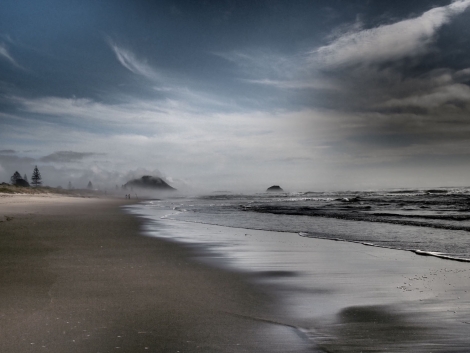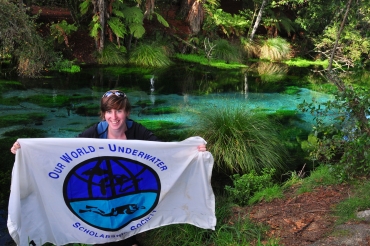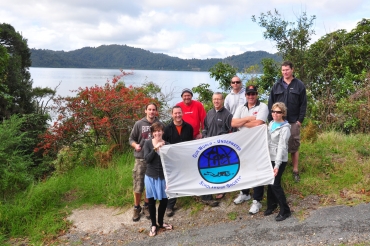I started the scholarship in Auckland, New Zealand. I completed my Advance Nitrox course, which was kindly sponsored by PADI and Pete Mesley. Pete also helped me get the hang of my new Olympus camera and set up. While in Auckland I received a full kit of gear from Tabata Australia and I was once again overwhelmed by their generosity! Thanks to Sue Crowe and the TUSA team for their support.
My first project is here in Tauranga, New Zealand. Shane Wasik and Nikki Limond have organised a group of volunteers to map a local wreck, the SS Taupo. The 130th anniversary of her sinking has just passed so to acknowledge the communities historic asset a group made up of many from the Mount Mounganui Underwater Club are coming together to gain more information about the dive site. The project aims to get a footprint of the wreck on the sea floor, carry out a basic marine biodiversity study and gather photo and video footage. All of this is working toward creating visitor guides, updating the wreck’s official records and will provide a baseline for future monitoring.
An Australian Institute of Maritime Archaeology (AIMA) course was organised for the volunteers on the project, to gain experience in maritime archaeology. The course was run by Andy Dodd from Historic Places Trust and Robert Brassey, Principle Specialist Cultural Heritage for the Auckland Council. It was very interesting and will definitely be useful for the future as I continue with projects in maritime and underwater archaeology. Before the mapping dives, the mapping team had some underwater archaeology practice at Lake Rotoma. The lake is just east of Rotorua and has a small dingy that is used for dive training, where we set a baseline and took our measurements –it was a good way to understand the procedures and practice carrying them.
The SS Taupo was a compound steam engine ship, 65 meters in length. She was built in Dunbarton, Scotland in 1875 and arrived in New Zealand on the 3rd July 1875 after a 138 day passage. She ran a fortnightly service carrying passengers and cargo along the East Coast of New Zealand until, in 1879, while entering the Tauranga harbour against a strong ebbing tide, she struck rocks at Stony Point. Two years later, in 1881 the SS Taupo was raised, patched and was towed toward Auckland. The concrete patches didn’t hold up and the pumps couldn’t cope. She was abandoned at 8pm on the 29th April 1881. The wreck of the SS Taupo was rediscovered in 1979 and in January of 1982 divers were caught blasting the wreck for the illegal salvage of metal. The wreck lies on a sandy bottom at 34 meters and is fragmented but still has large artefacts like the main boiler, compound engine block and bollards.
The planned dates for diving that were lined up saw a 5meter swell at the dive site, so the trip was postponed. Unfortunately the backup SS Taupo mapping dates were also postponed and so I miss out on helping with the dives. It is a shame, but this is the way things are with diving being so dependent on weather! I have learnt a lot about maritime archaeology through the AIMA course and dry and wet runs that took place over the course of my stay. I also managed to fit in some other side projects that have made my visit well worthwhile.
A recent side project of Shane’s is to put some artificial sea grass beds in the harbour to encourage seahorses to re-colonise the area. The natural sea grass beds throughout the harbour have declined over the past 50 years with the main factor is sediment and nutrient runoff.
This became my project during the week; I rustled up all the materials and sat down to make some artificial homes for the seahorse. We took the 70cm² sea grass bed down and planted it under the wharf at the boat club. There are occasionally seahorses on the pylons of the wharf so we thought this would be a good area to start with. A monitoring system over the next 3-5 years will hopefully show progress, and as the project goes on we are hoping to get more beds in along the harbour waterfront.
I also had an opportunity to help out with the location, capture, measurement and banding of grey-faced petrels carried out by the Department of Conservation and the Ornithological Society of New Zealand. The monitoring project has been carried out regularly since the 1990’s at Mount Maunganui and longer in the surrounding islands. A seabird we found was estimated at 30 years old!
Throughout my stay we went for a few dives in Pilot Bay on the harbour side of Mount Maunganui. For these photography dives we focused mainly on macro due to poor visibility. I took a couple of good shots and I am getting the hang of my Olympus Pen 2 camera. We also went for a drift dive down the Waikato River – it was beautiful blue water with good visibility. The Waikato River is the longest river in New Zealand; running from Mount Ruapehu through Lake Taupo and North to Port Waikato. The stretch that we dived is the cleanest part of the river as farm runoff and regular hydroelectric power stations decrease water quality downstream. The current was 4-5knots most of the dive and a few sporadic shallow areas meant bursts of speed which we took advantage of – striking our Superman poses and flying through the water, dodging boulders and fallen trees. On the way back to Tauranga we stopped at the beautiful blue fresh water Hamurana Springs. The springs produce an estimated 4 million litres of crystal clear water every hour! I snorkelled down the river (the spring itself is closed to diving) and saw many of the spring’s inhabitants including large rainbow trout, black teal, herons and the endangered dabchick.
While in Tauranga I met some important people in New Zealand’s diving industry including; Riaan Woest, SSI NZ General Manager; Eric Simmons, the President of New Zealand Underwater, who is involved in trying to retain the access rights for divers in Waikoropupu Springs and Riwaka Caves and Dave Moran, the editor of ‘Dive New Zealand’ Magazine.
Oceanz is a New Zealand dive conference that is taking place in Tauranga on the 12-13th November. The event is organised by Shane and Nikki and aims to bring together all things diving. There is a great lineup of speakers including Pete Bathune, as well as the showcasing of new products, equipment demos, a photography competition and Gala Dinner! This will be a great event for New Zealand diving enthusiasts!
I have had a wonderful time here in Tauranga, New Zealand. Thanks to Shane Wasik and Nikki Limond for their generosity, and Earth2Ocean for all their help with the Taupo project.

















Hi Anthea. Great to have you along to the petrels the other night. We have a permit from DOC to handle and band the birds but the project is an Ornithological Society of New Zealand (www.osnz.org.nz) initiative 🙂
Paul Cuming, OSNZ BOP